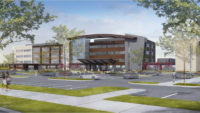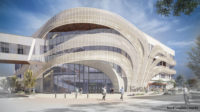The Denver office of AECOM Technology Corp. has carved out a major niche in the region's transit boom. The multidisciplinary consulting giant recently completed work, along with Kiewit Infrastructure and SOM, on the $500-million transformation of Denver's Union Station (DUS) into a regional transit hub. DUS celebrated its grand opening in May.
AECOM is continuing design work on the $350-million I-225 Light Rail line in Aurora, Colo., that is also being constructed by Kiewit as part of the Regional Transportation District (RTD)'s FasTracks program. "Those projects helped us build our transportation group in Colorado from 40 to around 100," says Rick Romig, AECOM's deputy project manager at DUS and the project manager on I-225 for the first six months of the job. "The jobs drew some of our best [AECOM] people here from across the country," he says.
Transit work, along with ongoing design and program management for other clients, helped AECOM boost its 2013 regional revenue to $90.2 million, up from $69.8 million in 2012, earning it the top spot in this year's ranking of Colorado/Wyoming design firms.
The company's portfolio is "a pretty even split between public and private work across the West, with more public-sector work in the Mountain States," says Scott Russell, AECOM's West region business line leader for buildings and places practices. The company is also the master landscape architect for the Stapleton neighborhood development in Denver, designing pools, parks and streetscapes for the past 10 years.
Creating a Transit Hub
At Union Station, AECOM worked with Parsons Brinckerhoff on preliminary site engineering and was part of the master development team as the general architecture and engineering consultant responsible for all specs and plans for the new transit center. That included track design, power systems, traffic reconfiguration, communications, signals and geotechnical, civil and structural engineering.
Romig says AECOM collaborated with Kiewit to create some of the transit hub's most complex elements, using sophisticated modeling for the flow of people, buses, light rail, commuter trains, mall shuttles and cars in a tight, congested area. "We identified the hot spots," Romig says. "Then we had to reorient elevators, change doors and so on, to handle anticipated peak traffic loads."
"The station has a very tight right-of-way and a design that we've never done before," says Rick Clarke, assistant general manager for capital programs at RTD, a key member of the Union Station ownership team. "It was a challenging design, working with multiple stakeholders and a lot of adjacent development. AECOM brought a depth of talent to the project."
AECOM also used in-house experts from its New York City hub to help design the multizone ventilation system in the station's massive underground bus terminal. The complex system helped the DUS team target LEED Silver, a first for large-scale transit projects in the U.S. AECOM's engineers designed the 22-bay terminal to sit on a 4-ft-thick "floating slab," Romig says. "That meant we didn't need a forest of piles, and it simplified waterproofing." AECOM also did the 2D flow model and rainfall analysis to help isolate the old station from a major flood.
AECOM also leads engineering and architecture work for the 10.5-mile-long I-225 Light Rail design-build project on an accelerated schedule. Construction began in March 2013 and should finish next January.
The project includes some tricky train alignments and hydrology through a dense urban area. Trains will run alongside the freeway and adjacent to city streets, with one segment down the middle of Exposition Avenue. The team had to redesign a section of track near the Fitzsimons medical campus in Aurora because of concerns about the impact of train vibrations on sensitive equipment. Overall I-225 design began in September 2012 and is now about 90% complete, Romig says.
Transportation Planning
The Colorado Dept. of Transportation selected the firm as portfolio management, cash management and program management contractor to oversee its Responsible Acceleration of Maintenance and Partnerships (RAMP) program and its regular capital improvement program. The combined contract value is around $900 million. "We are helping the agency better understand its entire program, from cash flow to budgeting, scheduling and delivery," says Alan Eckman, AECOM regional transportation business development manager.









Post a comment to this article
Report Abusive Comment